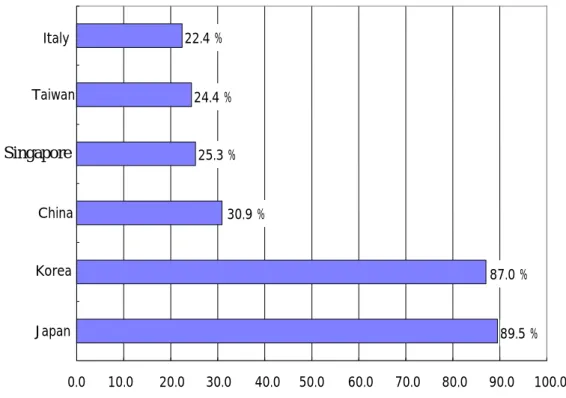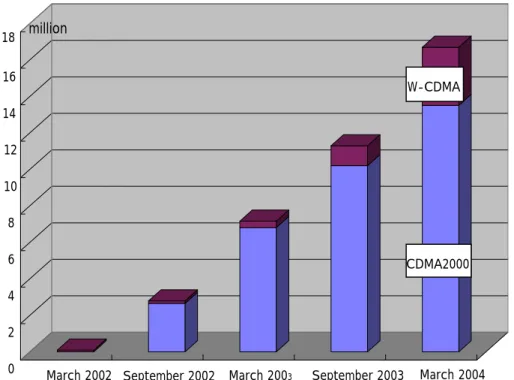Mobile Communications in Japan
byToshihiko Hayashi (林 敏彦) Chair, Stanford Japan Center
Professor of Economics, University of the Air
1. Brief History of Mobile Communication in Japan
Basic research on radio wave technology to be used in mobile communications started in 1960s in university laboratories. The technology had to wait another thirty years until it hit the market and transformed the way people communicate in and across societies.
The first commercial service for mobile telephone (1G) was provided by NTT Public Corporation in 1979 when they introduced the “automobile telephone”. Soon the equipment became detached from automobiles and was called “shoulder phone” as the device was the size of a small briefcase to be carried on a shoulder strap. As part of business response to a big change in the government regulation on telecommunications, new entries continued after 1985 in the mobile phone service market. 1G technology relied on the analogue transmission .
Table 1 A brief History of Mobile Communication in Japan 1979 NTTPC offers the world’s first automobile phone service
(1G).
1985-1988 New carriers enter the market. 1993 NTTDocomo begins PDC (2G). 1994 New entry continues.
Sale of terminal equipment starts. 1998 DDIcellular introduces the first CDMA. 1999 NTTDocomo introduces i-Mode (2.5G).
2000 Analogue transmission for mobile phone is terminated. 2001 NTTDocomo introduces FOMA on W-CDMA (3G) 2002 CDMA2000 competes with W-CDMA (3G competition).
In the beginning the equipment was expensive and the usage charge was higher compared to the fixed telephone. Naturally the first users who found the utility of mobile communication was the business. Mobile phones were a status symbol for business executives.
The second epoch was made when NTTDocomo introduced PDC service that used the digital transmission technology in 1993. Next year saw another important deregulation measure which allowed the sale of terminal equipments to the subscribers. Until then the handset had
been leased by the carriers to the subscribers. All sorts of colors and designs poured into the market attracting the attention of non-business users. Keitai markets flourished.
The expansion of the Keitai markets was brought about by successively declining cost of usage and a policy regime shift to allow sales of the mobile phones. Markets exploded attracting new group of users, most notably young people in high school age. They changed the image of mobile communication from business necessity to consumer attractions. They created innovative methods for Keitai communication.
With the advent of i-mode by NTTDocomo (2.5G) in 1999, conviviality set in among consumers, service providers, content providers and ornamental gadgets manufactures creating the Keitai culture. The first words people speak on the phone changed from “How are you?” to “Where are you?” Mobile phone became a device to watch rather than the device to speak in. Presently mobile phone is the most frequently used access to the Internet in Japan.
Today, 95 percent of households use mobile phones. The number of subscribers to the fixed telephone has been on the decline and is surpassed by mobile phone subscribers. One can originate and terminate calls in Shinkansen, on highways, in subways and underground towns as well as in every home and building. So much so that a law needed to be enacted to ban the usage of mobile phone while driving an automobile. Conductor has to make an announcement in trains and busses to refrain from using the mobile phone to their patrons. Professors frown when a ring tone goes out during the class. Mobile phone is not allowed in for entrance and other examinations. In other words, the Keitai ushered in a new communication manner in the society.
Figure 1 Number of Subscribers in Million
0 10 20 30 40 50 60 70 80 90 100
1997 1998 1999 2000 2001 2002 2003 2004
Fixed Telephone
Mobile Phone
Internet Services of Mobile Phone
The growth of mobile communications followed the typical patter of logistic curve. Along the path, penetration had to pass the critical mass, after which the growth followed the pattern which is akin to that of biological population growth of species. It starts slowly, then picks up the speed of penetration and reaches the maturing stage. By then a new path-breaking service or a killer content is introduced in the market and the process repeats again.
Looking back one can identify five important factors that led to the expansion of the mobile communication market in Japan; technology, regulatory regime shift, competition and the supporting cultural background.
2. The Internet
The internet penetrated in the Japanese society rather slowly after 1991 when internet service providers started to operate. Japan lagged behind US, European countries and some Asian countries. There were impediments to the growth of the internet. Business could afford to use the dedicated line for access. However, individuals and small and medium size enterprises had to use the analogue dial-up services. Then the telephone rates were rather high, personal computers were expensive, service providers were few in number, contents were poor, and consumers and business people were not accustomed to use the alphabet keyboard. In fact, people in their middle ages used to chuckle over their “keyboard allergy”.
Although the expectation for the coming information age was high, the slow growth of the economy after the burst of asset price bubbles in 1990 did not give enough impetus for the IT revolution. IT industry itself experienced a set back towards the end of the 90s. A disenchantment in the new technology emerged especially from the IT manufacturing sector.
However, CATV and DSL service led the way to the broadband services which made it possible to transmit pictures and movies without causing much stress. At this juncture, the mobile phone became available for the Internet access. In fact, the most notable characteristics of the Japanese Internet is that the dominant mode of access is provided by mobile phones. Solow paradox that indicated no connection between IT investment and the overall industrial productivity turned out to be a statistical illusion both in US and in Japan.
There was a renewed sense of revolution in the air. This time the government, industry and consumers all recognized that the information and communication technology (ICT) would revolutionize the society in many respects. Revolution in the Chinese sense may mean a change in heaven’s order to pass over political power from one dynasty to the other. Revolution in market place meant a massive shift of property rights from one sector to the other.
Today, the impact of ICT is felt in every corner of life today; business, politics, government administration, education, research, medicine, work place, local community, welfare and arts and culture. This was to be expected since the ICT changes the mode of communication between people.
3. Quest for Visual Communication
It is in this background that mobile phone penetrated so rapidly in Japanese business and households. One observer said that people use mobile phones on their ears in Europe and US but they use them at an arm’s length in Japan and China. When he said this he was referring to the fact that mobile phones in the West are a talking machine or used for voice transmission whereas in the East they are used as a canvas on which they draw pictures and characters.
One of the reasons why the ratio of internet service contracts in the total subscription to the mobile phone in Japan, Korea, China and Singapore seems to be rooted deeply in the tradition of visual communications in this part of the world. In the area under Chinese influence, people have developed the habit of visual communication. Chinese characters are symbols for concepts and meaning, not a phonetic sign. It was no coincidence that Japan developed the facsimile standard that spread the world. They wanted a good mode of visual communication.
4. Lessons from Japan’s Experience
Obviously there are bright side and dark side to every new technology. On the bright side, ICT including mobile technology will change the face of society in a better, more efficient, more transparent, more equitable and more meaningful way.
On the dark side, a system technology like ICT will create a divide between the netizen 89.5 %
87.0 % 30.9 %
25.3 % 24.4 % 22.4 %
0.0 10.0 20.0 30.0 40.0 50.0 60.0 70.0 80.0 90.0 100.0
Japan Korea China Taiwan
Italy
Figure 2 The Ratio of Internet Service Contract to the Total Mobile Phone Subscription
and those who fall off the net. This might lead to a wider gap in income distribution, regional disparity, and cultural richness. At the same time, digital inclusion or empowerment of the handicapped can take place enabling people to participate in business, education, and social intercourse.
It all depends on how wise an application we can make of ICT for the society at large. The privacy question, copyright protection in the digital age and security of the network are all important prerequisite for the future of information society. Some kind of international contrivance for the universal service needs to be established to let the people in the area with less developed mobile and other infrastructure to join the information society.
In the meantime, Japanese users are being lured into the 3G market. In Japan mobile internet was accepted so widely after 1999 that the introduction of 3G mobile was smooth and is gaining momentum. Whether or not the same phenomena will occur in the Chinese context is unknown. For the development of visual communication network, there ought to be a synergy between infrastructure technology and the creation of attractive digital contents.
Figure 3 3G Mobile Subscribers
However, I would place my bet on the prediction that Chinese 3G market will grow precipitously for two reasons: China’s long tradition of visual communications and the fact that the middle class in large cities is quickly emerging who are the strongest supporter for the new communication mode and they have much in common in lifestyle with the Japanese middle class. (All data are taken from the Communications White Paper, 2004.)
0 2 4 6 8 10 12 14 16 18
March 2002 September 2002 March 2003 September 2003 March 2004
million
CDMA2000 W-CDMA

